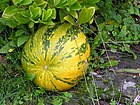Note: This is a project under development. The articles on this wiki are just being initiated and broadly incomplete. You can Help creating new pages.
Difference between revisions of "Cucurbita maxima - Alambu, Kola"
(→External Links) |
|||
| Line 89: | Line 89: | ||
[[Category:Herbs]] | [[Category:Herbs]] | ||
[[Category:Climber]] | [[Category:Climber]] | ||
| + | [[Category:Ayurvedic herbs that don't have flower, fruit and leaf photos]] | ||
| + | [[Category:Ayurvedic herbs that don't have seed photos]] | ||
Revision as of 14:13, 15 May 2019
Kushmanda, pumpkin has long been a staple vegetable of cultures throughout the world. It is cultivated for its delicious pumpkin fruit that is cooked, baked, dried and eaten.
Contents
- 1 Uses
- 2 Parts Used
- 3 Chemical Composition
- 4 Common names
- 5 Properties
- 6 Habit
- 7 Identification
- 8 List of Ayurvedic medicine in which the herb is used
- 9 Where to get the saplings
- 10 Mode of Propagation
- 11 How to plant/cultivate
- 12 Commonly seen growing in areas
- 13 Photo Gallery
- 14 References
- 15 External Links
Uses
Antidiabetic, Eliminate intestinal parasites, Regulates cholesterol, Strengthens immunity, Good for the heart [1]
Parts Used
Chemical Composition
Common names
| Language | Common name |
|---|---|
| Kannada | kumbala kaayi, see gumbala |
| Hindi | kaddu, meetha kaddu |
| Malayalam | chakkerakumpalan, mattan, mattanga |
| Tamil | carkkaraipparanki, parangi kayi, pushini, pushinik-kay |
| Telugu | gummadi kaaya, tiyya gummadi |
| Marathi | NA |
| Gujarathi | NA |
| Punjabi | NA |
| Kashmiri | NA |
| Sanskrit | dadhiphala, kushmanda, peetaphala, pitakushmanda, punyalatha |
| English | Pumpkin, Winter squash |
Properties
Reference: Dravya - Substance, Rasa - Taste, Guna - Qualities, Veerya - Potency, Vipaka - Post-digesion effect, Karma - Pharmacological activity, Prabhava - Therepeutics.
Dravya
Rasa
Guna
Veerya
Vipaka
Karma
Prabhava
Habit
Identification
Leaf
| Kind | Shape | Feature |
|---|---|---|
| Simple | alternate | Leaves 7-18 x 7-25 cm, orbicular or more or less reniform, entire or emarginate, 5-angled or lobed; petiole to 15 cm long. |
Flower
{{Flower|Unisexual|axillary, solitary|Yellow|3|axillary, solitary, large. Male flower: calyx-tube 5-8 mm long, campanulate, lobes 5, linear. Corolla 5-7 cm long, campanulate, yellow, lobes 5, apically recurved. Stamens 3; filaments 5-7 mm long; anthers linear, one 1-celled, others 2-celled. Female flower: Ovary oblong.}
Fruit
| Type | Size | Mass | Appearance | Seeds | More information |
|---|---|---|---|---|---|
| Pepo | Large | Seeds 18-22 x 10-12 mm | Ovate | {{{6}}} |
Other features
List of Ayurvedic medicine in which the herb is used
Where to get the saplings
Mode of Propagation
How to plant/cultivate
Season to grow
Soil type
Propagation
Commonly seen growing in areas
Photo Gallery
References
External Links
- Ayurvedic Herbs known to be helpful to treat Antidiabetic
- Ayurvedic Herbs known to be helpful to treat Eliminate intestinal parasites
- Ayurvedic Herbs known to be helpful to treat Regulates cholesterol
- Ayurvedic Herbs known to be helpful to treat Strengthens immunity
- Ayurvedic Herbs known to be helpful to treat Good for the heart
- Herbs with Flowers used in medicine
- Herbs with Fruits used in medicine
- Herbs with Seeds used in medicine
- Herbs with common name in Kannada
- Herbs with common name in Hindi
- Herbs with common name in Malayalam
- Herbs with common name in Tamil
- Herbs with common name in Telugu
- Herbs with common name in Sanskrit
- Herbs with common name in English
- Habit - Vine
- Index of Plants which can be propagated by Seeds
- Herbs that are commonly seen in the region of Tropical area
- Herbs
- Climber
- Ayurvedic herbs that don't have flower, fruit and leaf photos
- Ayurvedic herbs that don't have seed photos



